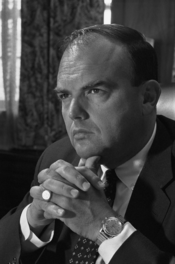Template:Are You Sure/April 27

—John Ehrlichman, White House counsel and presidential aide, quoted in "Legalize it all", Harper's Magazine, April 2016.
• ... that former White House counsel and Presidential aide John D. Ehrlichman (b. 1925) was released from an Arizona prison on this day in 1978 after serving eighteen months for Watergate-related crimes?
• ... that painter and inventor Samuel Morse (1791–1872) met artist and pioneering photographer Louis Daguerre in 1839 while visiting Paris, and that Morse become interested in the daguerreotype (the first practical means of photography), writing a letter to the New York Observer describing the invention; and that Mathew Brady, one of the earliest photographers in American history, famous for his depictions of the American Civil War, studied under Morse and later took photographs of him?
• ... that mathematician Paul Gordan (1837–1912) encouraged fellow mathematician David Hilbert and used Hilbert's results and methods, and the widespread story that Gordon opposed David Hilbert's work on invariant theory is a myth, although Gordon did correctly point out in a referee's report that some of the reasoning in Hilbert's paper was incomplete; and that Gordon is famously quoted (or misquoted — it is not clear if Gordan really said this, nor is it clear whether the quote was intended as criticism, or praise, or a subtle joke) as saying of Hilbert's proof of Hilbert's basis theorem: "This is not mathematics; this is theology."?
• ... that a nomogram (from Greek νόμος nomos, "law" and γραμμή grammē, "line"), also called a nomograph, alignment chart, or abaque, is a graphical calculating device consisting of a set of two or more scales (one for each variable in an equation), and a straight line (either drawn or virtual) called an index line or isopleth, which is drawn across the scales; and that (1) knowing the values of all but one variable, the value of the unknown variable can be found, and (2) by fixing the values of some variables, the relationship between the unfixed ones can be studied?
• ... that physicist and space activist Gerard K. O'Neill (1927–1992) graduated from high school in 1944, then enlisted in the United States Navy on his 17th birthday, and that the Navy trained O'Neill as a radar technician, sparking his interest in science?
• ... that biochemist and crystallographer John Kendrew (1917–1997) investigated the structure of heme-containing proteins, sharing the 1962 Nobel Prize for chemistry with Max Perutz for determining the atomic structures of proteins using X-ray crystallography; and that Kendrew's initial source of raw material for myoglobin was horse heart, but the myoglobin crystals thus obtained were too small for X-ray analysis so Kendrew then used whale meat, reasoning that the oxygen-conserving tissue of diving mammals could contain larger crystals?
• ... that the Fugu squash is a genetically engineered hybrid of the fugu fish and any of various types of squash, and that it was created as a vegan delicacy for high-end sushi restaurants?
• ... that author, mathematician, scientist, political activist, and educator Irving Adler (1913–2012) turned his attention, in the late 1970s, to the question of phyllotaxis, specifically to the arrangement of plant spirals according to the Fibonacci sequence, and that his papers in the Journal of Theoretical Biology stimulated a revival of interest in the subject?